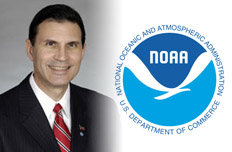Hubbard Radio Washington DC, LLC. All rights reserved. This website is not intended for users located within the European Economic Area.
On Air: Federal News Network
National Oceanic and Atmospheric Administration
-
Learn more about NOAA\'s turtle rescue efforts
August 24, 2010 -
Read about his experiences.
August 17, 2010 -
Today, the FCB hears from Joe Klimavicz, chief information officer and director of high performance computing and communications at NOAA. He tells us about some pilot programs they’re running in order to see if cloud…
August 17, 2010 -
In this installment of our Cool Jobs in Government series, we learn about an entire group of people who work on predicting weather in space.
August 12, 2010 -
This week, host Jason Miller interviews Joe Klimavicz of NOAA. Aug. 12, 2010
August 10, 2010 -
The Atlantic Basin remains on track for an active hurricane season.
August 06, 2010 -
Dr. Susan Solomon is with NOAA and works on global warming issues.
July 27, 2010 -
Let\'s face it, meetings are a necessary evil for the federal workforce. But what if you could use a collaboration tool that lets you participate digitally? The next generation of virtual collaboration tools are almost the next best thing to being there.
July 22, 2010 -
Track the evolution of the NOAA\'s measuring instruments and methods
July 21, 2010 -
Read more about NOAA\'s data.
July 16, 2010 -
Fourteen years ago, Congress passed the landmark Clinger-Cohen Act, creating the job of chief information officer in federal agencies. How has the job changed over the years, and what do today\'s CIOs think of their role?
July 01, 2010 -
The National Oceanic and Atmospheric Administration has launched a federal Web site meant to answer questions about the response to the B-P Gulf oil spill. Agency officials say it\'s designed as a one-stop shop for detailed near-real-time information about the response to the Deepwater Horizon incident, incorporating data from the various agencies that are working together to tackle the spill. Originally designed for responders, who make operational decisions regarding the disaster, the web site integrates the latest data on the oil spill\'s trajectory, fishery closed areas, wildlife and Gulf Coast resources into one customizable interactive map. The web site is http://www.GeoPlatform.gov/gulfresponse.
June 17, 2010 -
A new place users can go to map the Gulf oil spill.
June 16, 2010




